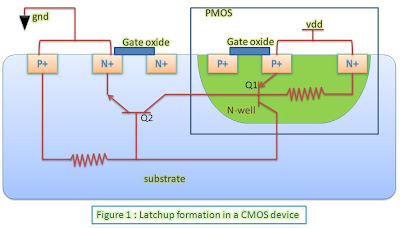The ever increasing size and number of
memories in the Systems on Chip has presented the designers and test engineers
with a challenge for huge number of functional or ATPG patterns for
verification of memory functionality. So, to test the memory functionality
either functionally or through ATPG requires huge test time, and hence, huge
test cost. It is almost impossible in such scenario to verify memory
functionality fully. Thus, the designers are left with only one way; i.e. to
verify memory functionality through BIST (Built-In Self Test) functionality.
BIST is an inbuilt testing circuitry
within a software/hardware module. We just need to trigger the circuitry from
outside. This circuitry, then, runs the inbuilt patterns/algorithms and returns
if the module is working properly. This, being inbuilt does not need to be
supplied with patterns from outside. Also, since, this is within a module,
hence, we can take the modular approach for testing which reduces run time
significantly.
 The built-in self test employed for
memories is known as MBIST (Memory Built-In Self Test). Like other BIST logic,
MBIST logic is inbuilt within memory only. The MBIST logic may be capable of
running several algorithms to verify memory functionality and test for memory
faults specifically designed and optimized for these.
The built-in self test employed for
memories is known as MBIST (Memory Built-In Self Test). Like other BIST logic,
MBIST logic is inbuilt within memory only. The MBIST logic may be capable of
running several algorithms to verify memory functionality and test for memory
faults specifically designed and optimized for these.There is usually a wrapper around memory, known as ‘memory collar’ that is used to select between functional inputs and test inputs based upon MBIST/functional mode selection bit. It interfaces the memory with on-chip logic and MBIST controller. The MBIST controller indicates the start of MBIST with a select input. The memory, then, starts the BIST algorithms and provides the test output to the controller. The controller compares this output with the reference output and indicates if the MBIST has passed or failed. There can be one controller for several memories. Also, memories can share the collar depending upon the test time requirement and type of memories.
Advantages of MBIST: There are several advantages of MBIST
insertion over functional/atspeed testing such as:
- It allows for robust testing of memories
- Reduced test time
- All the memories of the design can be tested in parallel
- Lesser test cost
Disadvantages of MBIST: Inspite of many advantage of MBIST, there is
only one remarkable limitation. Insertion of MBIST causes increase in area.
However, this increase in area is very small in comparison to the benefits it
provides.
Related posts:
